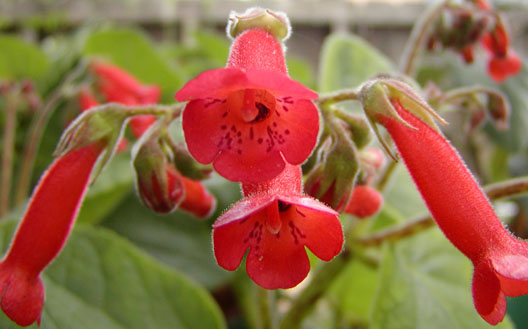Sinningia lineata
Sinningia lineata is an attractive,
easy-to-grow species with orange-red flowers atop (usually)
one or two pairs of large leaves per stem.
The flowers are spotted.
The amount of spotting depends on the clone.
The tuber can get very large with age,
both in cultivation and in the wild.
|
|
At the time of the 1988 Sinningia Register, there was a lot
of confusion between this species and S. macropoda.
The Register considered S. lineata to be a synonym of
S. macropoda,
but in the 1990s it was determined that in fact the names represented distinct species.
Most of the plants grown under the name S. macropoda in the 1970s
and 1980s were in fact S. lineata.
Sinningia macropoda
is not nearly as common in cultivation as
S. lineata.
|
Plants
|
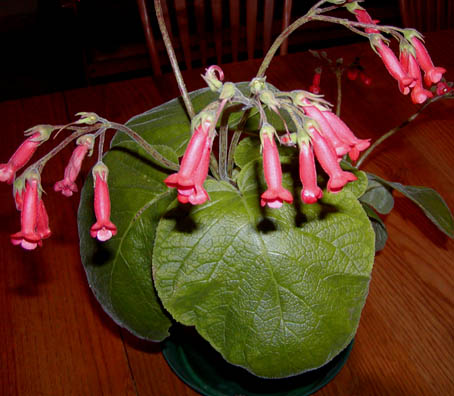
The 1976 plant in 2003.
|
I started S. macropoda
seed from the AGGS Seed Fund around 1976,
but the plant I got was
S. lineata.
The picture to the left shows the plant in 2003.
It had one main stem with four leaves.
Each leaf exil bore an inflorescence.
Leaves from a secondary stem bearing two inflorescences
can be seen at the right.
There is also a picture of its tuber.
|
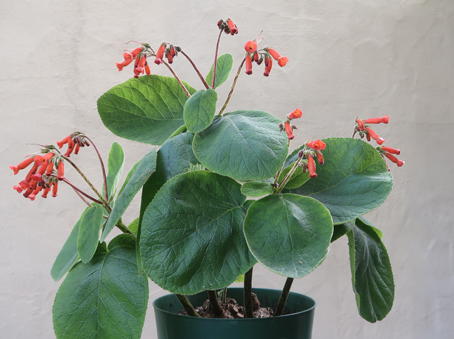
The 1976 plant in 2020.
|
As of May 2020, the plant is still flourishing.
It blooms well every year, but it has long since ceased to
be tidy, with multiple uncoordinated stems and a very
gnarly tuber.
It is my oldest sinningia.
Its primary blooming period is in the spring
(this picture was taken at the end of April),
but it has one or more subsequent blooming spurts
later in the year, with fewer flowers.
This plant is one of the parents of Sinningia
'Peninsula Belle'.
|
|
"Highly Spotted Clone"
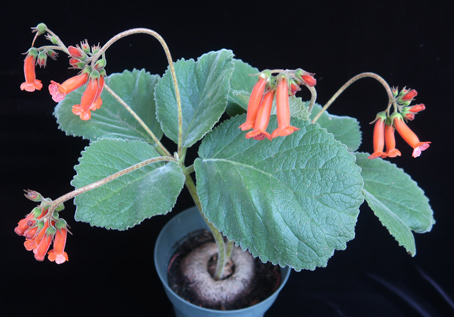
A Highly Spotted Clone plant in 2020.
|
Jon Dixon got seed from the AGGS seed fund a number
of years ago under the name "highly spotted clone".
This seed yielded a number of lineata-like plants,
with a variety of spotting in the flowers.
The plant in this picture was grown from Gesneriad Society
Seed Fund seed, sowed in 2008.
The seed could have been from the same source as Jon's, or
from Jon's plant.
Unlike the 1976 plant, this one's peduncles are not sturdy
enough to bear the weight of the flowers, so they hang down
rather than more or less horizontally.
Also, the 12-year-old tuber is a tidy bagel shape instead
of the gnarly disorganized one of the 1976 plant.
These differences in physical properties suggest that the
two plants are from separate collections of the species or
even the product of a little hybridization, perhaps the sort
of unwanted hummingbird-driven crossing that I get in my
yard.
|
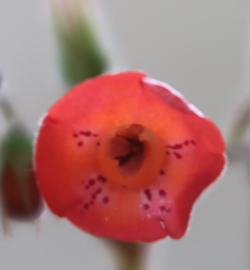
Normal clone flower.
|
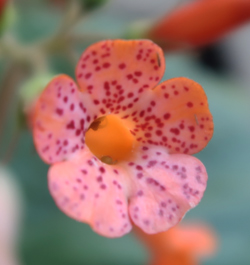
Spotted clone flower.
|
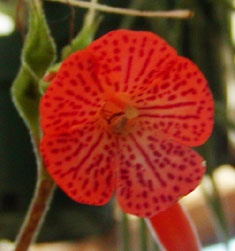
Spotted clone flower.
|
These pictures show flowers from three different plants.
The one at the left is the 1976 plant.
It has a little spotting at the junctions of the four bottom
lobes, but none between the upper two lobes and none in the
interiors of any of the lobes.
The middle picture is from the 2008 plant.
It shows scattered spotting on the faces of all five lobes,
not just at the boundaries.
The pattern of dots does not look regular, neither within a
lobe nor between opposite or adjacent lobes.
The right-hand picture shows one of Jon's plant.
It has the most spotting.
Here the markings do show some regularity, as if lined up in
rows radiating from the center.
The flowers of these three plants differ in the shape of
their lobes.
On the other hand, within each flower, lobe shape is very
similar -- the flowers are almost radially symmetric, at least
in the face of the corolla.
See the discussion of floral symmetries
for more information.
|
|
|
In 1999, the GRF expedition saw S. lineata growing in muddy ground
beside a creek.
It was Brazil autumn, and the foliage was very tattered.
Some of the tubers were already dormant.
They were easily the biggest tubers we saw in Brazil on that trip,
up to 12 inches [30 cm] in diameter.
|
This is one of those species which takes quite a while to reach maturity.
If you sow seeds, you must be prepared to be patient in waiting for the first bloom.
In hybridization, however, this slowness can be negated by
appropriate choice of mate.
S. 'Peninsula Belle' is
S. lineata
x reitzii.
When I selfed this hybrid, the resulting F2 plants took
several years to bloom.
When I crossed S. 'Peninsula Belle' with
S. conspicua,
on the other hand, the hybrids bloomed about
a year after germination.
Crosses with S. 'Texas Zebra'
bloomed less than a year after germination.
It appears that the rapid maturity of (for example)
S. conspicua
and (in 'Texas Zebra')
S. eumorpha
trumps the slowness of
S. lineata.
Time from seed may also have to do with culture.
S. piresiana has been
another slow bloomer from seed for me,
but two plants obtained from crossing it with
S. 'Peninsula Belle' bloomed within 16 months.
|
This is the place where I tell one of my favorite stories.
In 1984, the annual convention of the American Gloxinia and Gesneriad Society was held in
northern California, in San Mateo, a city about 15 miles south of San Francisco.
I had never attended a convention before, much less entered a plant in a convention show.
But this particular year, my youthful plant of Sinningia lineata
put on a spectacular display.
Usually, it is through blooming by the middle of June, but this year it peaked right
at convention time.
I had dreams of grandeur as I brought it to the entries table.
It was loaded with flowers.
It had perfect leaves.
Who knew how high it could go?
And then I saw the killer:
a gorgeous Sinningia leucotricha with multiple stems,
spectacular leaves, and dozens of flowers.
When culture and condition are the same,
it comes down to genes vs. genes, and face it,
Sinningia leucotricha
has better genes.
Long story short: it got 98 points, mine got 97.
My wonderful plant didn't even get a blue ribbon.
But here's the deal.
That leucotricha went on to take Best in Show.
Losing out to the Best in Show, well, worse things can happen.
But most important, I got a priceless gift.
That was 1984.
This plant had never before looked as good, nor has it ever done so
in all the years since then.
I was able to show it to an international membership at its lifetime peak.
And now, every spring, when I look at that plant blooming, I am reminded
of Tom Polka, the exhibitor of the splendid leucotricha,
a fine person and perhaps the San Francisco chapter's best grower,
who died over 20 years ago.
I learned a lot from that 1984 convention.
|
The plant does have one difficulty in my environment: caterpillars.
Because it is outdoors and blooms early in spring and has plain green
leaves (which appear to appeal best to the moths around here), it is
particularly vulnerable.
I have to be vigilant, watching the apical buds for signs of the pests.
The primary symptom is leaves dwarfed and curled over to conceal the
developing vermin.
|
Feature table for
Sinningia lineata
Plant Description
|
| Growth |
Determinate |
| Habit |
2-3 leaf pairs |
| Leaves |
Large, green |
| Dormancy |
Stems fully deciduous.
Dormancy is obligate.
|
Flowering
|
| Inflorescence |
terminal peduncle |
| Season |
Blooms in spring |
| Flower |
Orange-red, tubular |
Horticultural aspects
|
| From seed |
I no longer have records for the first bloom of my plant, seed sown 1977.
However, hybrids between this plant and others are very slow to bloom;
see discussion |
| Hardiness |
Has survived 25F (-4C) in my yard |
| Recommended? |
Yes. The tuber gets larger and larger and larger... |
Hybridization
|
| Hybrids with this species |
See listing. |
Botany
|
| Taxonomic group |
The lineata group
of the Dircaea clade. |
| Nectaries |
Two, dorsal, joined or nearly so |
|
Does anybody know why botanical citations insist on abbreviating people's names?
Anyway, Rechsteineria lineata was published by "Hjelm." in 1937.
The Plant-Book by Mabberley gives a "Hjelmq." as Karl Jesper Hakon Hjelmquist
(b. 1905), which is in the right time range.
Alain Chautems transferred this species to Sinningia in 1990.
(The International Plant Name Index
confirms that Hjelm. is the same as Hjelmq. which is the
above-mentioned Karl Jesper fellow.)
|
|
Etymology: Latin lineata ("lined"), from the streaks on the
stems and flowerstalks.
|
